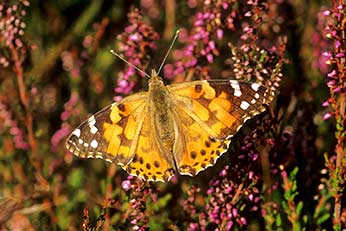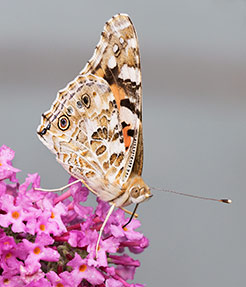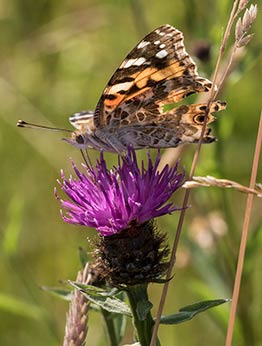Painted Lady (Cynthia cardui)
- a beautiful visitor to the New Forest
When: Typically early April until late October, although significant numbers can be expected only from late-May with stragglers sometimes into October and November.
How many: This migrant butterfly occurs in variable numbers - in some years it is relatively scarce, whilst in other years it is present in huge numbers.

Painted Lady butterflies are beautiful creatures and it's no surprise that they carry such an exquisite name. The association with attractive females is not just a British fancy, either, for in France the butterfly is known as La Belle Dame.
Painted Ladies are migratory butterflies that can be found all over Europe, North Africa, Asia, North America and Australia up to an altitude of around 3,000 metres.
They are fairly unmistakable, too, with gloriously coloured upperwings that have a subtle orange to salmon pink background colour, often tinged with a rosy hue, onto which has been sprinkled black veins and dark brown to black spots and patches liberally marked with white blotches. (They frequently, and very obligingly, show off this remarkable colour scheme when at rest as the wings then are often held outstretched).
Average wingspan is 64mm to 70mm (2½ to 2¾ inches) which, by UK standards, is quite large for a butterfly - to put this into context, they are very similar in size to the perhaps more familiar Red Admirals and Peacocks. But the size of Painted Ladies does seem to be far more variable than that of many other species: some seem to be incredibly small compared to those of 'standard' size.
Male Painted Ladies are highly territorial and will often chase off other males of their own kind and, indeed, sometimes butterflies of other species, too. Flight is often quite rapid and of short duration - the males, at least, do not like to leave their territories unguarded for any length of time.

Painted Ladies are, though, perhaps best known for longer distance travel, for these seemingly fragile creatures are migratory insects that cannot successfully over-winter in the British Isles but instead make incredible annual journeys, spreading northwards in spring from the desert fringes of North Africa, the Middle East and central Asia, recolonising mainland Europe and eventually reaching Britain and Ireland. They've even been found inside the Arctic Circle - they're the only butterflies to have been recorded in Iceland!
Radar tracking has established that they fly at speeds of up to 30 miles per hour, maybe assisted by prevailing winds, and at dizzying heights of up to 3,000ft, which is obviously far too high to see with the naked eye.
Small numbers typically arrive in southern England in early spring before other settlers arrive later in spring and summer. And just as remarkably, many of the off-spring of these visitors, and maybe the offspring of their offspring (!), head south in late summer and early autumn to spend the UK winter in warmer climes. Whether any of the original migrants make the return journey is open to conjecture.
(Until 2009, it was not known for certain whether Painted Ladies made the return journey at the end of the summer, like the closely related Red Admiral, or simply perished in the UK. Radar tracking helped solve this mystery in conjunction with more than 60,000 public sightings recorded across Europe - around 10,000 British observers took part in this impressive citizen science initiative).
Numbers of Painted Ladies involved in these migrations vary: relatively few arrive in some years and hardly venture farther north than the south of England, whilst in other years vast swarms arrive in wave after wave, and colonise virtually the whole country.
Individual insects do not, however, necessarily make the complete journey. Indeed, it may be that few, if any do, certainly during the spring migration. In 2009, for example, a spectacular 'Painted Lady' year when millions of these insects reached Britain and Ireland, huge numbers apparently congregated in Morocco before moving on to Spain where they produced a generation that moved north and arrived in Britain and Ireland in late May and early June. These in turn produced a further generation that migrated south in September. (It has been estimated that 11 million Painted Ladies arrived in Britain and 26 - 29 million departed).

Richard Fox from Butterfly Conservation said at the time: 'The extent of the annual journey undertaken by the Painted Lady butterfly is astonishing. This tiny creature weighing less than a gram with a brain the size of a pin head and no opportunity to learn from older, experienced individuals, undertakes an epic intercontinental migration in order to find plants for its caterpillars to eat'.
And that sums up so well the achievements of this splendid creature. But irregular abundance was noticed as far back as at least the 19th century for, writing in 1860, W.S. Coleman stated that: 'The appearance of this butterfly in any given locality is a matter of great uncertainty, though it capriciously visits, and even abounds occasionally in almost every place'.
Coleman did, however, quite wrongly state that the Painted Ladies seen in early spring were 'hybernated specimens'. But we must be reasonable when judging our predecessors, for insect flights from Africa to Britain, and back, were no doubt beyond man's wildest imaginings in the 19th century, and probably for much of the 20th century.
(In 2019, fully ten years after the last big 'Painted Lady' year, unusually large numbers of these butterflies were reported in Cyprus in late March and early April, and subsequently from mainland Europe, offering the prospect of another bumper year. And sure enough, by early August, Painted Ladies were present in the New Forest (and much of the rest of the UK) in large numbers, providing a real treat for those with even a passing interest in the natural world).
References:
Butterflies of the British Isles: J.A. Thomas
Butterflies of Hampshire: Matthew Oates, John Taverner, David Green, et al
The Millennium Atlas of Butterflies in Britain and Ireland: Jim Asher, Martin Warren, Richard Fox, Paul Harding, Gail Jeffcoate and Stephen Jeffcoate
British Butterflies: W.S. Coleman
Butterfly Conservation - 2019: the year of the Painted Lady?
BTO News, November/December 2012 - Butterfly mystery finally solved with citizen science help
The Telegraph - painted ladies migrate thousands of miles
More links
Search this site

Sadly, 58 animals were killed - 35 ponies, 13 cows, 8 donkeys and 2 sheep, whilst a further 32 were injured - 3 pigs, 9 donkeys, 11 cows and 9 ponies.
(Forty-three accidents occurred in daylight, 15 at twilight and 101 in the dark. Twenty-seven accidents were not reported by the driver involved).
Here's just one horrific example - Three donkeys killed in collision with van at notorious New Forest blackspot (Advertiser and Times)

